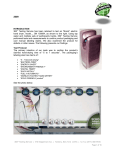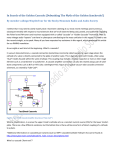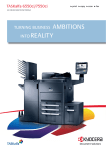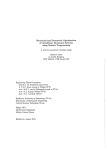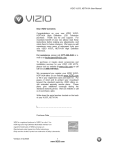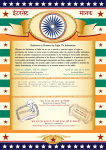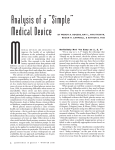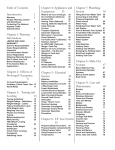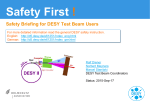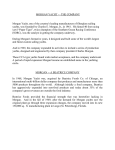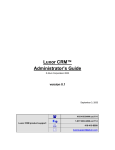Download Station
Transcript
Station T___ Hand-Held Search Monitor for Special Nuclear Materials User’s Manual Paul E. Fehlau 1 Contents PREFACE . . . . . . . . . . . . . . . . . . . . . 3 . . . . . . . . . . . . . . . . . . 4 INTRODUCTION YOUR SEARCH MONITOR . . Built-In Intelligence . . . General Description . . . Power On/Off Switch . . Reset Button . . . . . . Thumbwheel Switch (Delta Count Rate Meter . . . . Battery Check . . . . . Alarm . . . . . . . . . Battery Charge . . . . . GAMMA RADIATION . Radiation Sources. Contamination . . Background Radiation Summary . . . . . . . . . . . . . . . . . . . . . . . MONITOR OPERATION . . Battery Recharge . . . Power On Setting the Ba&kgr&~d. Setting the Alarm Level SEARCH TECHNIQUES . General Procedures. Preparation for Search Personnel Search . . Package Search . . . Motor Vehicle Search What To Do When You Search Checklist . . NOTES 2 . . . . . . . . . . Rate . . . . . . . . . . . . . . . . . . . . . : . . (Delta . . . . . . . . . . . . Find . . . . . . . . 6 . 7 . 8 . 10 . 10 . 10 . . . . . . . . . . . . . . . Monitor . . . . . . . . . . . . . . . . . . . . . . . . . . . . . . . only) . . . . . . . . . . . . . . . . . . . . . . . . ...11 ...11 ...13 ...13 . . . . . . . . . . ...14 . . .16 ...18 . . . 18 ...19 . . . . . . . . . . . . . Rate . . . . . . . . . . . . . . . . . . . . . . . . . . . . . . . Monitor . . . . . . . . . . . . . . . . . . . . . . . . . . . . . . Radioactive . . . . . . . . . . . . . . . . . . . . ...20 . . . . . . only). . . . . . . . . . . . . . . . . . . Material . . . . . . . . . . ...26 ...28 . . . ...37 . . . . . . . . . . . . . . . . . . . ...38 .20 . 20 . 22 . 23 . 24 .24 . 25 .30 . 36 Preface This manual is for security guards who use a hand-held monitor to search people, packages, and vehicles for radioactive material. It provides instructions for using the monitor to its maximum sensitivity in searching for radioactive materials. The manual is both a teaching tool and a handy reference. It acquaints first-time users with the search monitor and the proper techniques for searching. It also is a refresher for guards who have been reassigned to a search station. Finally, it serves as a reference at search stations by providing summaries, checklists, and places to record station-specific information. 3 Introduction One of your most important duties as a security guard is to prevent unlawful removal of special nuclear materials from access areas. Plutonium and enriched uranium qualify as special nuclear materials that are vital to the security of the United States. The Department of Energy and the Nuclear Regulatory Commission require guards to search all persons, packages, and vehicles for these materials at exits from access areas. 4 The search is conducted with a hand-held monitor that detects radiation emitted by special nuclear materials. The monitor has detectors that are particularly sensitive to gamma radiation. By using the monitor properly to conduct exit searches, you can detect even small quantities of plutonium and enriched uranium. When the monitor senses gamma radiation, it beeps more and more often as you move it toward radioactive material. This makes it possible for you to conduct a search by listening to the beeps. You do not have to watch the meter. You will know you have located the radiation source when the monitor beeps most frequently. It is relatively easy to detect a large quantity of radioactive material: the monitor senses it from a distance. It is not so easy to detect small quantities of radioactive material, but they are just as important to find. Your monitor cannot sense a small quantity of radioactive material unless it is nearby. This means that you have to scan all surfaces, within a few inches, and take the time to do a thorough job. Read this manual carefully. It will acquaint you with the parts of your monitor, examine the fundamentals of gamma radiation, explain how to operate the monitor, and recoin mend search techniques. A copy of this manual should be available at every search station. Write the name of the station on the cover. Record information specific to the station in the blank spaces on pages 22, 23, and 36. Use the blank pages at the end of the manual (pages 38-39) to note special procedures in effect at that station. 5 Your Search Monitor Detecting gamma radiation is the most effective way to search for hidden quantities of special nuclear materials. Although searching without a radiation monitor might meet the requirements of the Department of Energy and the Nuclear Regulatory Corn mission, that kind of search is slow and may not always locate the nuclear material. Because all nuclear material is radioactive and emits gamma radiation, searching with a gamma-ray monitor is a better way to find it. Two hand-held search monitors that detect gamma radiation were developed at Los Alamos National Laboratory. You are probably using one of them, either the Personnel-Vehicle Monitor or the Delta Rate Monitor. The Personnel-Vehicle Monitor is a sensitive, general-purpose 6 instrument more commonly used at search stations. The Delta Rate Monitor is a more specialized instrument for stations where the radiation intensity is highly variable. A thumbwheel switch on the Delta Rate Monitor allows the operator to compensate for these changes in intensity. At present, these two hand-held gamma-radiation monitors with built-in intelligence are in widespread use at search stations. Newer versions of these monitors will be similar in design and operation to the Personnel-Vehicle Monitor and the Delta Rate Monitor. Even if you are using a different modelj the information in this manual will be useful to you. Built-In Intelligence Many hand-held monitors can sense the weak gamma radiation that is part of our natural environment, which is called background radiation. They also can sense an increase in gamma-ray intensity over the background radiation near special nuclear material. However, most monitors are not particularly suited to search requirements at exit stations because the user has to watch a count-rate meter and interpret the information. This diverts his attention from the search. The most useful in?Xruments for searching by hand are monitors that signal increases in radiation intensity with a noise, such as a beeping sound. The beeps allow the user to concentrate on the search instead of on watching the meter. We call these monitors intelligent because they can remember the intensity of the background radiation and will beep when the new intensity is greater than the background. The Personnel-Vehicle Monitor and the Delta Rate Monitor both have built-in intelligence. 7 General Description Your search monitor has a gamma radiation detector inside it along with some electronics that operate the instrument. The radiation detector is located just under the power switch inside the case. Each monitor also contains a battery to power the electronics. The, compact and lightweight monitor is designed for hand use. The aluminum case and its contents weigh only 4 pounds. For its size and weight, the monitor is highly sensitive. Familiarize yourself with the dials and switches on the control panel. In particular, note the location of the POWER ON/OFF switch, the RESET button, the BATTERY TEST button, and the AUDIBLE ALARM (the beeper). The count-rate meter displays radiation intensity in counts per second, which is the count rate. It is not necessary to watch the meter when you are conducting a search, but it will display the count rate when you press the button in the handle. Grasp the monitor firmly in one hand so that read the writing on the front panel. The sensitive monitor points away from you, as it should during However, the monitor also senses radiation from and the bottom. 8 you can end of the a search. the sides SENSITIVE END < [ COUNTS PER SEC 500 ‘+ .AUDIBLE ] ALARM, POWER ON ) g;% ..,;,’* .,:..%...L. ,- ... ,.V .++i . ;:W.::K, .* c:. L.:+::+.:,.::::;: , .,:. ...... ..~;.,.:. . . .. ,.:,..; -., L, . ... RESET ...r,,.,.:.; .:.;.::., ~~..,. ~.r.,.~.,, .?. -J . ........ :., . ,. . .. .. ., . ,.... ....:/..,, SYSTEM .....;,, , ,. .,..,,........%.! :..... ..... ,‘.1.’.f..,:,t~i~j...:..*.’>.’! ,’;-;+$. ;.?*~.>,, ,,:,.;~i ;g~$j$j>::?g~<:+:s:.::::;: .. . .. , E M [d J I IL r— 0 CHARGER u I_@ BATTERY TEST- @ o \ PUSH BUTTON TO READ COUNT-RATE METER \ THUMBWHEEd SWITC )elta Rate Monitor onl 9 POWER ON k!d RESET SYSTEM M Power On/Off Switch An essential first step to monitoring is to turn the monitor on. It can’t do its job otherwise. Reset Button When you press and release the RESET button, the monitor begins a short background measurement that lasts about 3 seconds. At the end of the measurement, the monitor records the radiation background value. Do not use the monitor to conduct any part of a search while this background measurement is in progress. Remember to count to 3 after you release the button before you start searching. Thumbwheel Switch (Delta Rate Monitor Only) The Personnel-Vehicle Monitor and the Delta Rate Monitor look quite similar. One difference is the thumbwheel switch, labeled DELTA SELECT, on the Delta Rate Monitor. By adjusting the switch to a higher setting, you can maintain the monitor’s sensitivity during short periods of high radiation background. But remember to lower the setting as soon as possible. 10 Count-Rate Meter The count-rate meter on the Personnel-Vehicle Monitor operates when you press a button in the front part of the handle. By pressing the button, you can display the radiation intensity in counts per second. The Delta Rate Monitor has a digital display that registers the background count rate continuously. I COUNTS PER SEC 500 I Battery Check The BATTERY TEST button on the PersonnelVehicle Monitor allows you to test the battery charge. When you press the button, the needle indicates whether the battery charge is adequate or low. Instead of a battery test button, the Delta Rate Monitor indicates a low battery by a flashing digital display. m 11 If your monitor beeps too often or not often enough, update the background. 12 Alarm -AUDIBLE ALARM . The monitor beeps occasionally when no source is nearby because it is continuously measuring the radiation intensity in very short counting-time intervals. The intervals are not much longer than the length of one of the beeps. The measurements are not exact. Most of them are near the background intensity, but a few always are a bit too large. The large ones trip the monitor’s alarm. Therefore, if the instrument beeps too often or not often enough, the stored background needs updating. Of course, when a radioactive source is nearby, the monitor should beep frequently. Battery Charge When the battery is low, it can be recharged. First turn off the monitor. Then attach the charger cable to the monitor and plug the charger into a wall socket. CHARGER o 0● u 13 Gamma Radiation Gamma radiation is emitted by radioactive atoms that are part of the natural environment. Gamma radiation is similar to light, except that the eye cannot see it. A radiation source emits gamma rays in all directions, just as a light bulb emits light in all directions. And, just as the intensity of light fades rapidly as you move away from a light bulb, the intensity of gamma radiation fades as you move away from its source. This comparison is true for bare light bulbs only; reflectors or lamp shades can redirect visible light, but there is no way to redirect the flow of gamma radiation. 14 q Move in close with your monitor to find radioactive materiai. PV w & The closer your ; c q monitor comes to radioactive material the greater the gamma-ray intensity and the easier it is to find the material. To find radioactive material, you should follow the direction of increasing intensity, that is, more frequent beeps. However, certain shields in the path of gamma rays block their passage, just as objects in the path of light create a shadow. Look for shields that may shadow radioactive material and prevent your monitor from detecting it. For example, brick and concrete walls, thick metal cont[ and sheets of lead are shields that stop gamma rays. .. 












































